Oracle PMO Metrics: Selection and Justification (PRJ-60)
VerifiedAdded on 2023/01/11
|5
|1135
|69
Report
AI Summary
This report analyzes the implementation of a Project Management Office (PMO) within Oracle Corporation, focusing on the selection and justification of key performance metrics. The assignment addresses three critical categories: process management and improvement, project performance, and business management. For each category, the report identifies two suitable metrics, drawing from Gerard Hill's book, and explains the rationale behind their selection, tying the choices to Oracle's specific needs and objectives. The chosen metrics include cost of quality, return on investment, balanced scorecard, flow framework, customer value analysis, and action-profit linkage. The report emphasizes the importance of these metrics in assessing project success, improving organizational efficiency, and aligning PMO activities with Oracle's strategic goals. The document also provides a table summarizing the selected metrics and their alignment with Oracle's needs, along with specific steps to achieve targets for each metric over a three-year period.
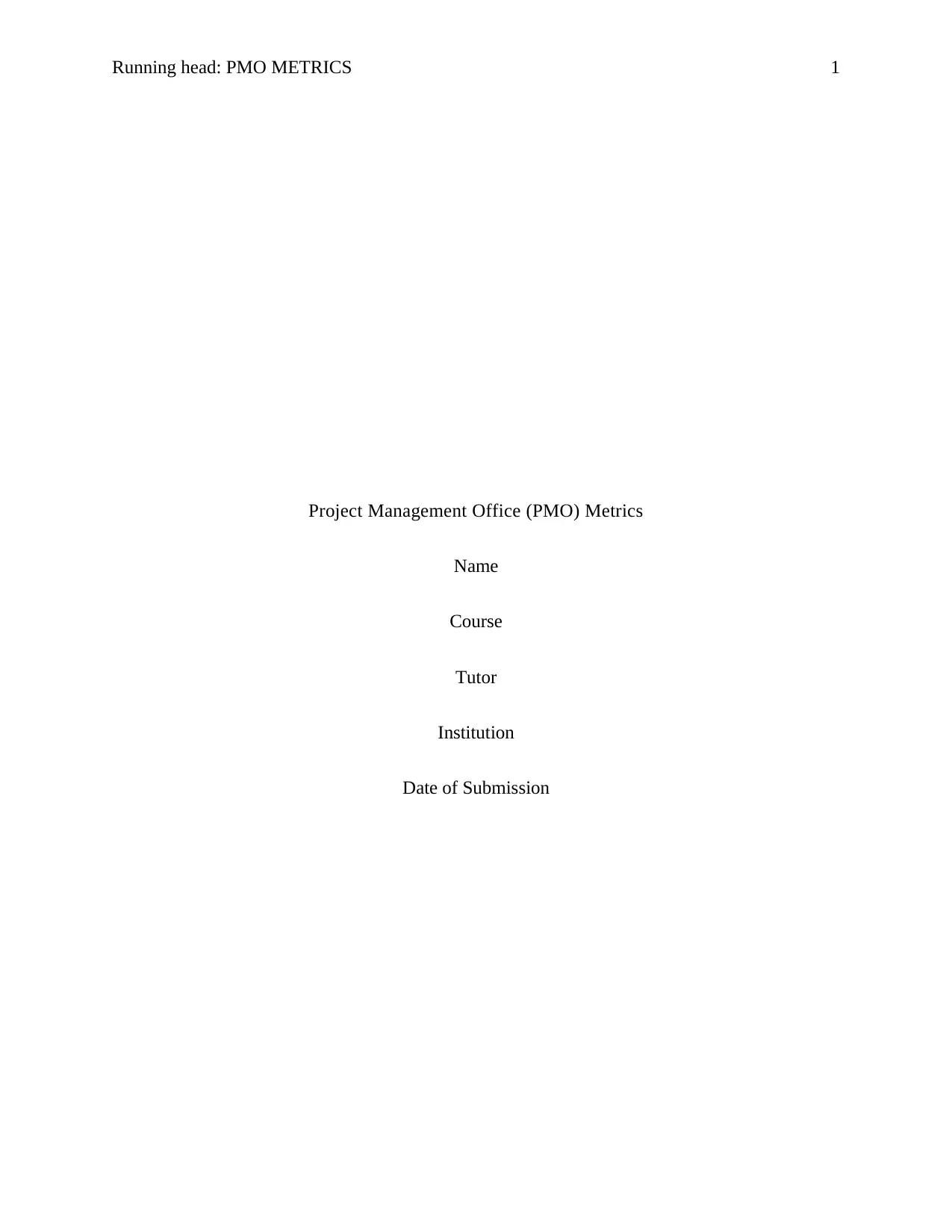
Running head: PMO METRICS 1
Project Management Office (PMO) Metrics
Name
Course
Tutor
Institution
Date of Submission
Project Management Office (PMO) Metrics
Name
Course
Tutor
Institution
Date of Submission
Paraphrase This Document
Need a fresh take? Get an instant paraphrase of this document with our AI Paraphraser
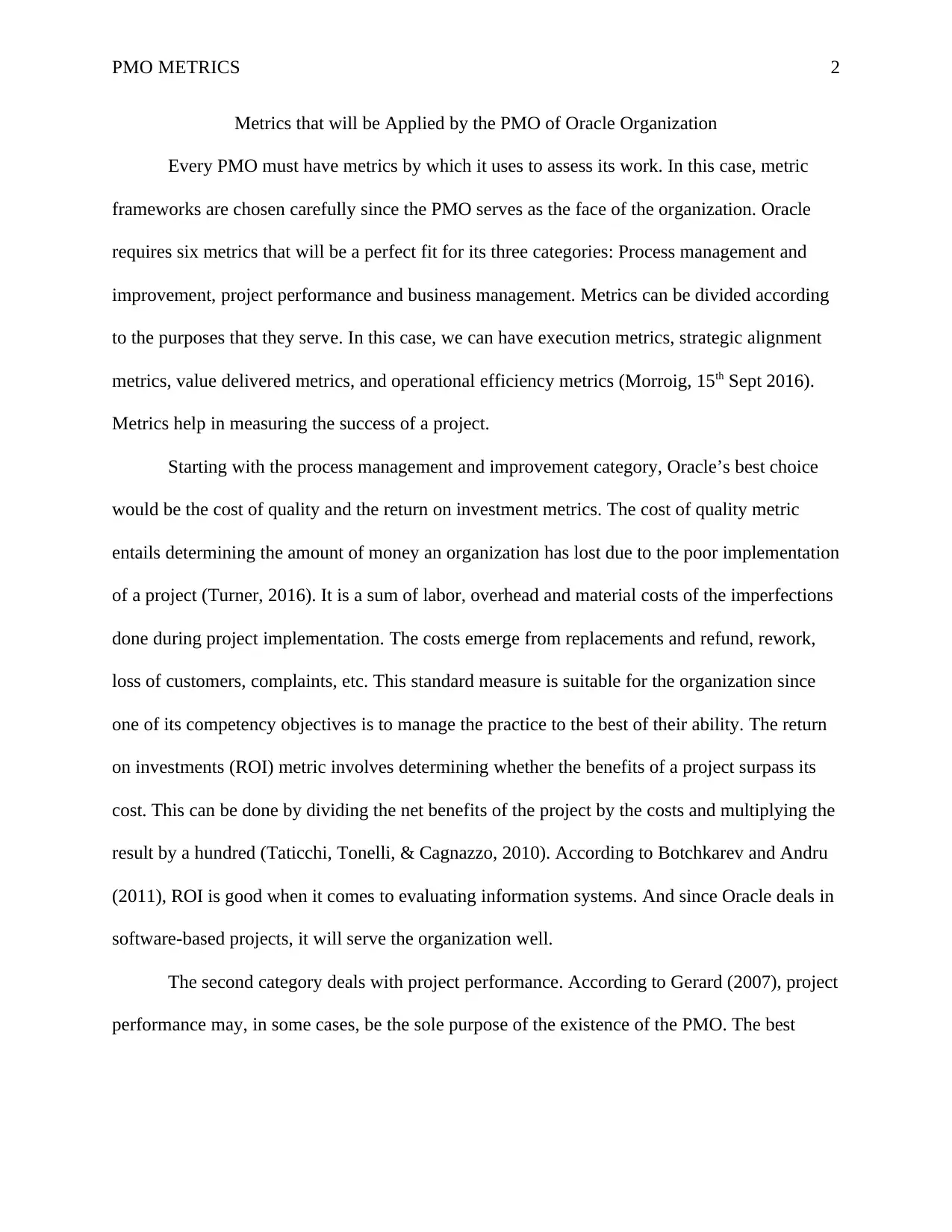
PMO METRICS 2
Metrics that will be Applied by the PMO of Oracle Organization
Every PMO must have metrics by which it uses to assess its work. In this case, metric
frameworks are chosen carefully since the PMO serves as the face of the organization. Oracle
requires six metrics that will be a perfect fit for its three categories: Process management and
improvement, project performance and business management. Metrics can be divided according
to the purposes that they serve. In this case, we can have execution metrics, strategic alignment
metrics, value delivered metrics, and operational efficiency metrics (Morroig, 15th Sept 2016).
Metrics help in measuring the success of a project.
Starting with the process management and improvement category, Oracle’s best choice
would be the cost of quality and the return on investment metrics. The cost of quality metric
entails determining the amount of money an organization has lost due to the poor implementation
of a project (Turner, 2016). It is a sum of labor, overhead and material costs of the imperfections
done during project implementation. The costs emerge from replacements and refund, rework,
loss of customers, complaints, etc. This standard measure is suitable for the organization since
one of its competency objectives is to manage the practice to the best of their ability. The return
on investments (ROI) metric involves determining whether the benefits of a project surpass its
cost. This can be done by dividing the net benefits of the project by the costs and multiplying the
result by a hundred (Taticchi, Tonelli, & Cagnazzo, 2010). According to Botchkarev and Andru
(2011), ROI is good when it comes to evaluating information systems. And since Oracle deals in
software-based projects, it will serve the organization well.
The second category deals with project performance. According to Gerard (2007), project
performance may, in some cases, be the sole purpose of the existence of the PMO. The best
Metrics that will be Applied by the PMO of Oracle Organization
Every PMO must have metrics by which it uses to assess its work. In this case, metric
frameworks are chosen carefully since the PMO serves as the face of the organization. Oracle
requires six metrics that will be a perfect fit for its three categories: Process management and
improvement, project performance and business management. Metrics can be divided according
to the purposes that they serve. In this case, we can have execution metrics, strategic alignment
metrics, value delivered metrics, and operational efficiency metrics (Morroig, 15th Sept 2016).
Metrics help in measuring the success of a project.
Starting with the process management and improvement category, Oracle’s best choice
would be the cost of quality and the return on investment metrics. The cost of quality metric
entails determining the amount of money an organization has lost due to the poor implementation
of a project (Turner, 2016). It is a sum of labor, overhead and material costs of the imperfections
done during project implementation. The costs emerge from replacements and refund, rework,
loss of customers, complaints, etc. This standard measure is suitable for the organization since
one of its competency objectives is to manage the practice to the best of their ability. The return
on investments (ROI) metric involves determining whether the benefits of a project surpass its
cost. This can be done by dividing the net benefits of the project by the costs and multiplying the
result by a hundred (Taticchi, Tonelli, & Cagnazzo, 2010). According to Botchkarev and Andru
(2011), ROI is good when it comes to evaluating information systems. And since Oracle deals in
software-based projects, it will serve the organization well.
The second category deals with project performance. According to Gerard (2007), project
performance may, in some cases, be the sole purpose of the existence of the PMO. The best
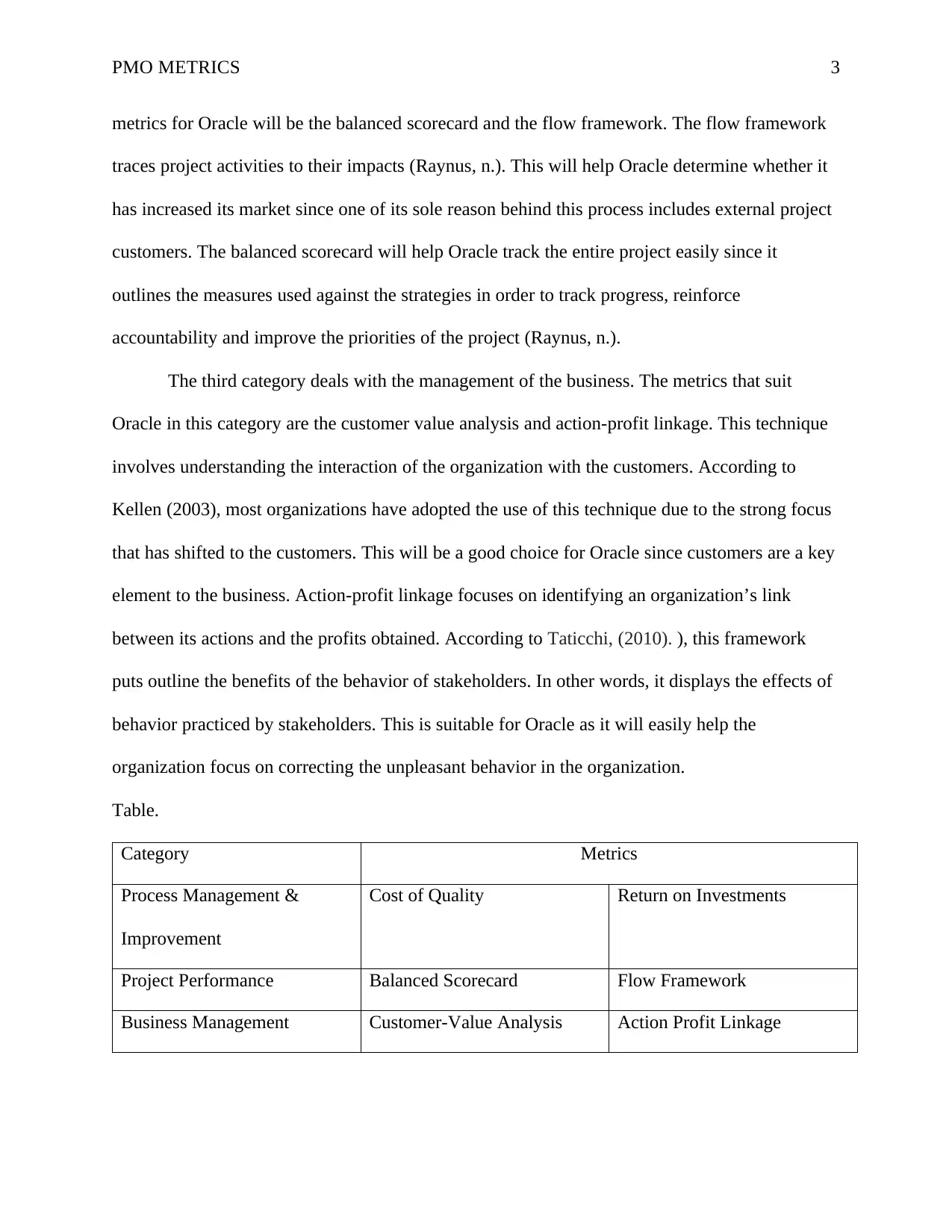
PMO METRICS 3
metrics for Oracle will be the balanced scorecard and the flow framework. The flow framework
traces project activities to their impacts (Raynus, n.). This will help Oracle determine whether it
has increased its market since one of its sole reason behind this process includes external project
customers. The balanced scorecard will help Oracle track the entire project easily since it
outlines the measures used against the strategies in order to track progress, reinforce
accountability and improve the priorities of the project (Raynus, n.).
The third category deals with the management of the business. The metrics that suit
Oracle in this category are the customer value analysis and action-profit linkage. This technique
involves understanding the interaction of the organization with the customers. According to
Kellen (2003), most organizations have adopted the use of this technique due to the strong focus
that has shifted to the customers. This will be a good choice for Oracle since customers are a key
element to the business. Action-profit linkage focuses on identifying an organization’s link
between its actions and the profits obtained. According to Taticchi, (2010). ), this framework
puts outline the benefits of the behavior of stakeholders. In other words, it displays the effects of
behavior practiced by stakeholders. This is suitable for Oracle as it will easily help the
organization focus on correcting the unpleasant behavior in the organization.
Table.
Category Metrics
Process Management &
Improvement
Cost of Quality Return on Investments
Project Performance Balanced Scorecard Flow Framework
Business Management Customer-Value Analysis Action Profit Linkage
metrics for Oracle will be the balanced scorecard and the flow framework. The flow framework
traces project activities to their impacts (Raynus, n.). This will help Oracle determine whether it
has increased its market since one of its sole reason behind this process includes external project
customers. The balanced scorecard will help Oracle track the entire project easily since it
outlines the measures used against the strategies in order to track progress, reinforce
accountability and improve the priorities of the project (Raynus, n.).
The third category deals with the management of the business. The metrics that suit
Oracle in this category are the customer value analysis and action-profit linkage. This technique
involves understanding the interaction of the organization with the customers. According to
Kellen (2003), most organizations have adopted the use of this technique due to the strong focus
that has shifted to the customers. This will be a good choice for Oracle since customers are a key
element to the business. Action-profit linkage focuses on identifying an organization’s link
between its actions and the profits obtained. According to Taticchi, (2010). ), this framework
puts outline the benefits of the behavior of stakeholders. In other words, it displays the effects of
behavior practiced by stakeholders. This is suitable for Oracle as it will easily help the
organization focus on correcting the unpleasant behavior in the organization.
Table.
Category Metrics
Process Management &
Improvement
Cost of Quality Return on Investments
Project Performance Balanced Scorecard Flow Framework
Business Management Customer-Value Analysis Action Profit Linkage
⊘ This is a preview!⊘
Do you want full access?
Subscribe today to unlock all pages.

Trusted by 1+ million students worldwide
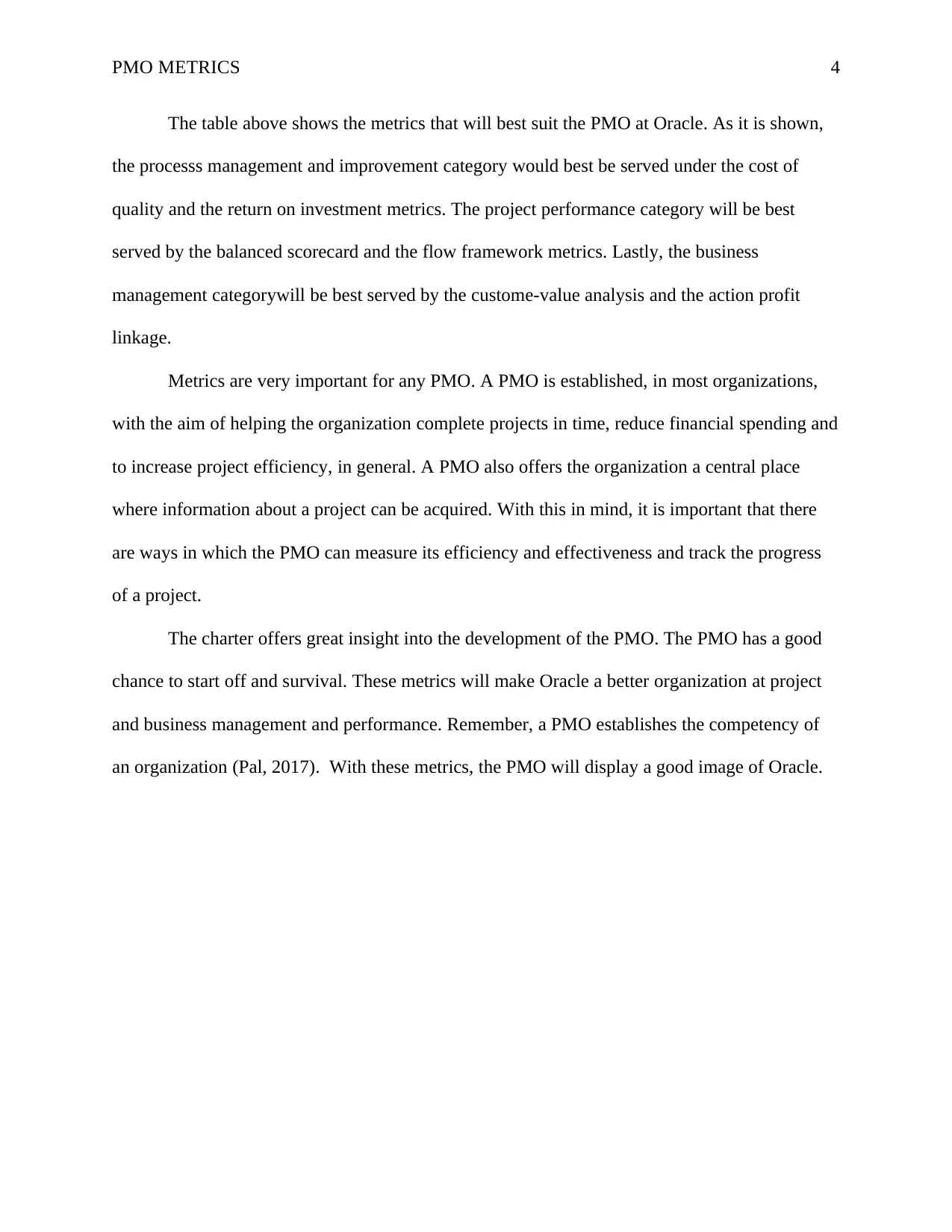
PMO METRICS 4
The table above shows the metrics that will best suit the PMO at Oracle. As it is shown,
the processs management and improvement category would best be served under the cost of
quality and the return on investment metrics. The project performance category will be best
served by the balanced scorecard and the flow framework metrics. Lastly, the business
management categorywill be best served by the custome-value analysis and the action profit
linkage.
Metrics are very important for any PMO. A PMO is established, in most organizations,
with the aim of helping the organization complete projects in time, reduce financial spending and
to increase project efficiency, in general. A PMO also offers the organization a central place
where information about a project can be acquired. With this in mind, it is important that there
are ways in which the PMO can measure its efficiency and effectiveness and track the progress
of a project.
The charter offers great insight into the development of the PMO. The PMO has a good
chance to start off and survival. These metrics will make Oracle a better organization at project
and business management and performance. Remember, a PMO establishes the competency of
an organization (Pal, 2017). With these metrics, the PMO will display a good image of Oracle.
The table above shows the metrics that will best suit the PMO at Oracle. As it is shown,
the processs management and improvement category would best be served under the cost of
quality and the return on investment metrics. The project performance category will be best
served by the balanced scorecard and the flow framework metrics. Lastly, the business
management categorywill be best served by the custome-value analysis and the action profit
linkage.
Metrics are very important for any PMO. A PMO is established, in most organizations,
with the aim of helping the organization complete projects in time, reduce financial spending and
to increase project efficiency, in general. A PMO also offers the organization a central place
where information about a project can be acquired. With this in mind, it is important that there
are ways in which the PMO can measure its efficiency and effectiveness and track the progress
of a project.
The charter offers great insight into the development of the PMO. The PMO has a good
chance to start off and survival. These metrics will make Oracle a better organization at project
and business management and performance. Remember, a PMO establishes the competency of
an organization (Pal, 2017). With these metrics, the PMO will display a good image of Oracle.
Paraphrase This Document
Need a fresh take? Get an instant paraphrase of this document with our AI Paraphraser
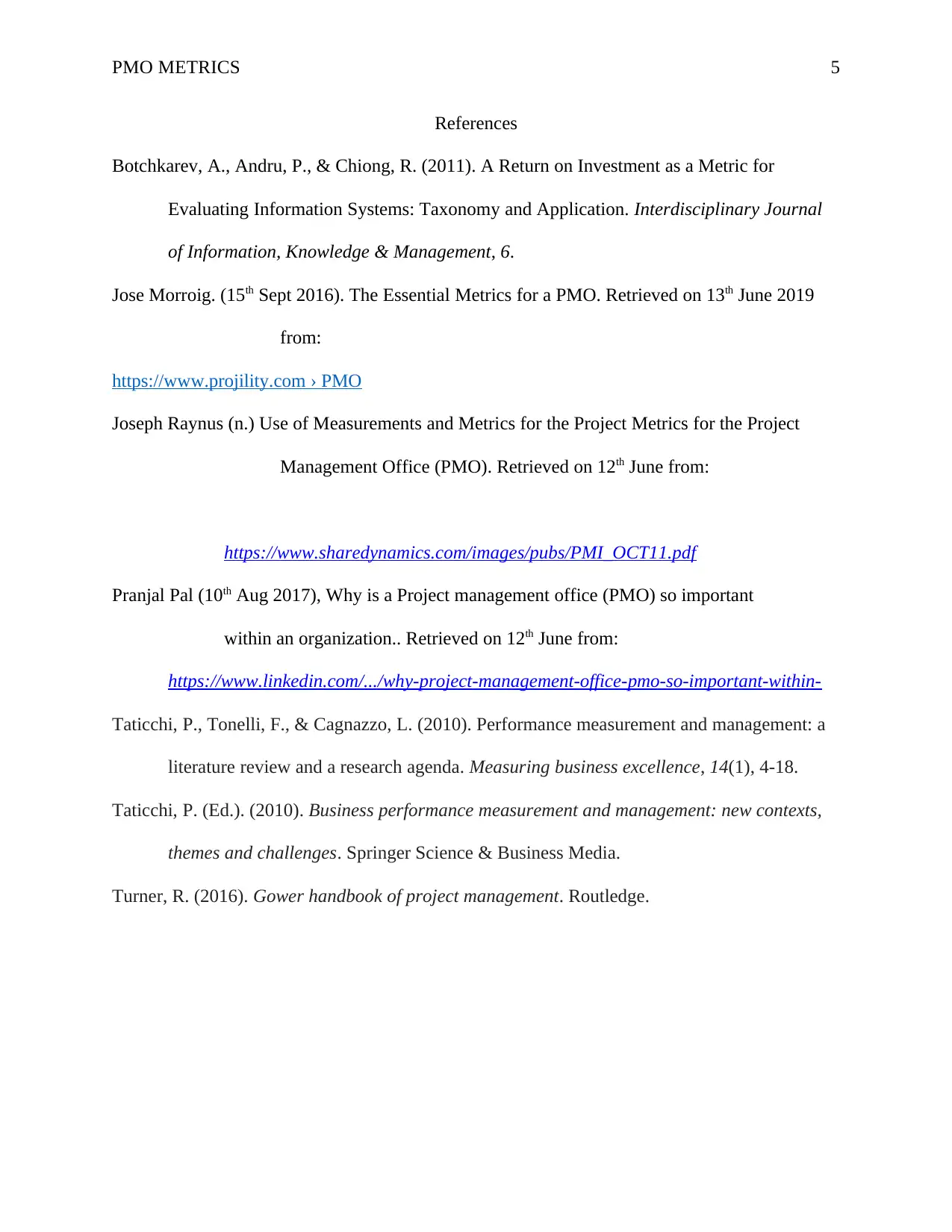
PMO METRICS 5
References
Botchkarev, A., Andru, P., & Chiong, R. (2011). A Return on Investment as a Metric for
Evaluating Information Systems: Taxonomy and Application. Interdisciplinary Journal
of Information, Knowledge & Management, 6.
Jose Morroig. (15th Sept 2016). The Essential Metrics for a PMO. Retrieved on 13th June 2019
from:
https://www.projility.com › PMO
Joseph Raynus (n.) Use of Measurements and Metrics for the Project Metrics for the Project
Management Office (PMO). Retrieved on 12th June from:
https://www.sharedynamics.com/images/pubs/PMI_OCT11.pdf
Pranjal Pal (10th Aug 2017), Why is a Project management office (PMO) so important
within an organization.. Retrieved on 12th June from:
https://www.linkedin.com/.../why-project-management-office-pmo-so-important-within-
Taticchi, P., Tonelli, F., & Cagnazzo, L. (2010). Performance measurement and management: a
literature review and a research agenda. Measuring business excellence, 14(1), 4-18.
Taticchi, P. (Ed.). (2010). Business performance measurement and management: new contexts,
themes and challenges. Springer Science & Business Media.
Turner, R. (2016). Gower handbook of project management. Routledge.
References
Botchkarev, A., Andru, P., & Chiong, R. (2011). A Return on Investment as a Metric for
Evaluating Information Systems: Taxonomy and Application. Interdisciplinary Journal
of Information, Knowledge & Management, 6.
Jose Morroig. (15th Sept 2016). The Essential Metrics for a PMO. Retrieved on 13th June 2019
from:
https://www.projility.com › PMO
Joseph Raynus (n.) Use of Measurements and Metrics for the Project Metrics for the Project
Management Office (PMO). Retrieved on 12th June from:
https://www.sharedynamics.com/images/pubs/PMI_OCT11.pdf
Pranjal Pal (10th Aug 2017), Why is a Project management office (PMO) so important
within an organization.. Retrieved on 12th June from:
https://www.linkedin.com/.../why-project-management-office-pmo-so-important-within-
Taticchi, P., Tonelli, F., & Cagnazzo, L. (2010). Performance measurement and management: a
literature review and a research agenda. Measuring business excellence, 14(1), 4-18.
Taticchi, P. (Ed.). (2010). Business performance measurement and management: new contexts,
themes and challenges. Springer Science & Business Media.
Turner, R. (2016). Gower handbook of project management. Routledge.
1 out of 5
Related Documents
Your All-in-One AI-Powered Toolkit for Academic Success.
+13062052269
info@desklib.com
Available 24*7 on WhatsApp / Email
![[object Object]](/_next/static/media/star-bottom.7253800d.svg)
Unlock your academic potential
Copyright © 2020–2025 A2Z Services. All Rights Reserved. Developed and managed by ZUCOL.





